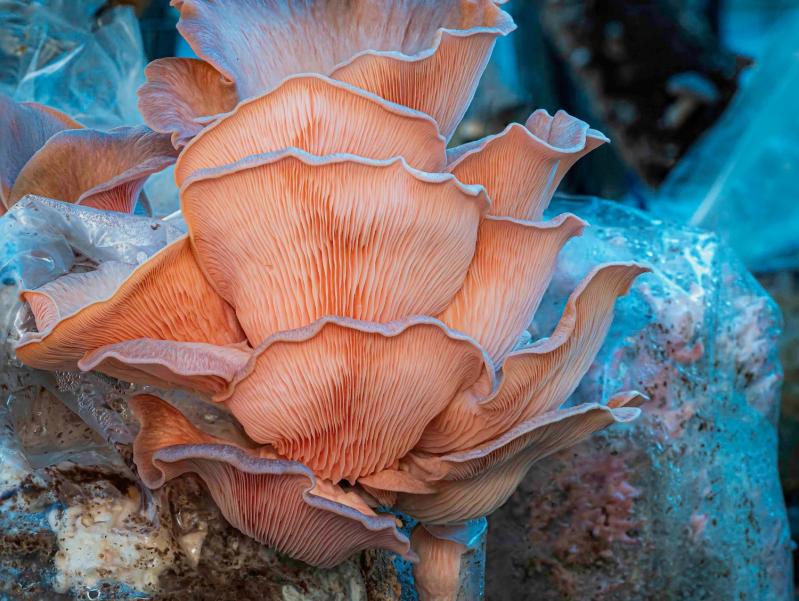I confess my intention for writing this article is self-serving: I’m intimidated by the delicate-looking oyster mushrooms and the funky white snowballs of lion’s mane mushrooms. Yet for health and environmental reasons, we should eat more mushrooms.
Turning off bustling Sound Avenue in Mattituck and into a tranquil gravel driveway, I’ve come to the Mattituck Mushrooms farm to learn more. A lazy dog thumps his tail to greet me and chickens squawk with curiosity. They’re a country doorbell and Anthony Holbrooke emerges to introduce himself. Holbrooke and Agathe Snow, who are artists, have run Mattituck Mushrooms for five years, producing 400 pounds per week in the summer and 150 pounds in the winter. They sell to individuals at their farm stand and farmers markets, plus East End restaurants including Almond, Topping Rose, and Armin and Judy in Bridgehampton and Alpine in Franklin Square.
Under a canopy of trees, Snow guides me through the clear dome greenhouses, resembling igloos, that contain shelves of mushrooms growing on blocks of pressed wood pulp. The enclosures provide an environment to control temperature, moisture, air flow, and light.
The mushrooms growing from the blocks look like funky microcosms as they reach up to the dappled sunlight: the ethereal wavy yellow and blue oyster, toasty brown button-shape chestnut, rippled maitake, and fluffy white round lion’s mane. Each block produces roughly three pounds of mushrooms per cycle. When the blocks are spent after several cycles, they’re returned to nature and composted, creating a minimal carbon footprint through the growing process.
From a health perspective, eating mushrooms makes nutritional sense: They’re lower in cholesterol and fat when compared with meat, while offering protein and fiber. The high mineral content and broad spectrum of amino acids appeal, as well.
Studies referenced by the National Institutes of Health highlight the “bioactive proteins” that offer antioxidant, antiviral, antifungal (how meta!), and cancer-fighting properties. This benefits the immune system, brain health, and gut balance. The nutritional profile varies among mushroom varieties, and growing conditions influence nutrients, too. Oyster mushrooms contain more than twice the iron of common button mushrooms. Snow recommends exposing mushrooms to light before eating them, as this increases the vitamin D within.

“People ask why our mushrooms taste so good. We’d like to take the credit, but the mushrooms do all the work,” says Holbrooke.
He and Snow have studied the conditions in which specific mushroom varieties thrive, and when mushrooms prefer to grow. They’ve learned which varietals thrive in summer heat and which ones continue to produce through winter conditions. They note the quality of their water source, the aquifer from Laurel Lake. Given that fungi are 80 percent water, this matters.
But how to cook with these wholesome fungi?
“People come up with cool recipes all the time,” says Snow. Maitake (also called hen of the woods) are great on the grill or roasted. Snow recommends searing lion’s mane in a dry cast-iron pan, then pressing and flipping the mushrooms every few minutes to expel some of the moisture so they become crispy. She adds oil and thyme midway through cooking. Mushrooms pair well with fish, polenta, pasta, or Asian noodle dishes. When Snow mentions vegan crab cakes, I note the culinary challenge.
The farm stand also sells homemade tinctures, honey infused with lion’s mane mushrooms, mushroom broth, and blocks to grow mushrooms at home. Stored in a paper bag in the main section of a refrigerator, mushrooms will keep for a week. The excess moisture in a refrigerator’s produce drawer will turn them mushy, while leaving mushrooms on a counter for more than a few hours causes them to dry out. Cooked mushrooms or broth can be stored in the freezer.
I leave Mattituck with brown paper bags filled with oyster, chestnut, maitake, and lion’s mane mushrooms, and head to Aki’s Kitchen located in Westhampton to glean Aki Goldberg’s culinary insight. Goldberg takes a less-is-more approach to creating veg-forward soups and dishes that she has sold in area farmers markets and shops for four years. She highlights the flavors of quality ingredients and takes pride in offering nourishing and nurturing dishes. All of this makes her a perfect person to ask about cooking mushrooms.
RELATED: Recipe for Vegan Crab Cakes
We chat as she cuts off the woodier stems and slices the larger mushrooms. She demonstrates how simply sautéing them over medium-high heat in minimal oil or butter, minced garlic, and sprigs of thyme draws out the rich umami. We taste them before and after she adds fresh lemon zest, and it’s interesting how it adds a brightness to the flavor. It’s possible to taste the subtle fishy flavor of oyster mushrooms. The earthier shitake complement the lighter coral and maitake mushrooms. Goldberg says the sautéed medley would go well with hummus and roasted pignoli. To make a quick meal, she recommends adding a little cream or white wine to the sautéing mushrooms and serving over pasta. I was on my own to cook the lion’s mane mushrooms, but followed Snow’s suggestion of making faux crab cakes. A friend with sharp opinions about food would be an ideal guinea pig for a recipe I sourced from Food and Wine magazines “40 Best” recipes list. I followed the recipe exactly, except for eyeballing a volume of shredded mushroom to replace a pound of crab. We marveled at the crispy golden brown in the cast-iron skillet.
They were off the charts. The flaky texture was similar to crabmeat, yet my friend and I preferred the lightness of the mushrooms to crab. Per Snow’s guidance, I froze the remaining crab cakes for another meal. Definitely a dish to enjoy again.

